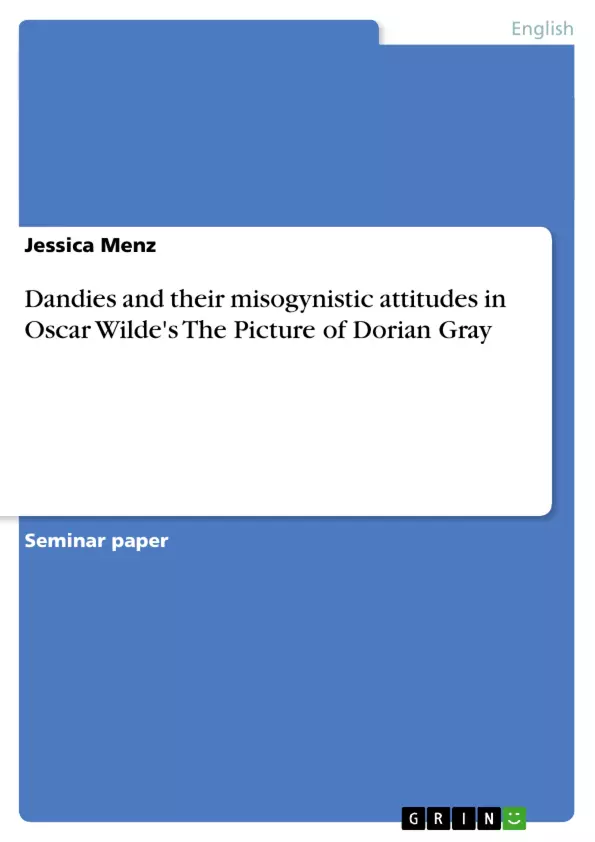Oscar Wilde’s The Picture of Dorian Gray is a novel of the Victorian ‘fin de siécle’. Its protagonists are dandies, who follow the principle of a so-called New Hedonism. Under the influence of the elder Lord Henry, Dorian Gray assumes his way of life, thinking and even his attitude to women. Actually the entire novel is shaped by a certain misogynistic culture that reveals itself in different forms. In this paper I am going to illustrate how the male characters, mainly the dandies Lord Henry and Dorian, use their voice to speak up against women, whereas the female ones remain voiceless most of the time.
Apart from its fictional content, the novel is full with concepts that shaped Victorian society. To get a full understanding, I am therefore going to illustrate the novel’s historical context and some of the phenomena of the Victorian ‘90s, for example, New Hedonism, Dandyism etc. I am then going to give a description of the dandies in the novel, Lord Henry Wotton and Dorian Gray, before illustrating their misogynistic attitudes. I will be looking for reasons as well as describing the different types of women that are in the novel, focusing on Sibyl, the most important female character in the novel.
Inhaltsverzeichnis (Table of Contents)
- Introduction
- The Picture of Dorian Gray and the Victorian Age - the novel in its historical context
- The Victorian Age – an era with many different faces
- Morality, sexuality and gender roles in Victorian society
- New phenomena: Dandy and New Woman
- Dandies and their misogynistic attitudes in The Picture of Dorian Gray
- The dandies in the novel: Lord Henry Wotton and Dorian Gray
- Misogynistic attitudes towards women in the novel
- Examining reasons for the dandies' misogynistic attitudes in the novel
- Conclusion
Zielsetzung und Themenschwerpunkte (Objectives and Key Themes)
This paper examines the misogynistic attitudes of the male characters, particularly the dandies Lord Henry and Dorian, in Oscar Wilde's The Picture of Dorian Gray. The study analyzes the novel's historical context within the Victorian ‘fin de siécle’, exploring key social and cultural phenomena such as the rise of New Hedonism and Dandyism. The analysis delves into the portrayal of women in the novel and investigates the reasons for the dandies' misogynistic views.
- The role of dandies in shaping Victorian society
- The representation of women and their voices in the novel
- Misogynistic attitudes and their influence on the narrative
- The historical context of the Victorian ‘fin de siécle’ and its impact on the novel
- The influence of New Hedonism and Dandyism on the characters and their actions
Zusammenfassung der Kapitel (Chapter Summaries)
The first chapter introduces the topic and provides background information on Oscar Wilde’s The Picture of Dorian Gray, highlighting the central theme of misogyny and its manifestation in the characters. It also establishes the novel's historical context within the Victorian era.
Chapter two delves into the social and cultural landscape of the Victorian Age, exploring its multifaceted nature, including its moral and social complexities. It analyzes the changing roles of men and women in Victorian society, specifically focusing on the emergence of the "New Woman" and the Dandy. The chapter examines the influence of Victorian morality, sexuality, and social norms on the novel's narrative.
Chapter three focuses on the characterization of the dandies Lord Henry and Dorian Gray, examining their attitudes towards women. It analyzes their misogynistic views and explores the reasons behind them. The chapter also looks at the portrayal of women in the novel, focusing on Sibyl Vane, the most significant female character.
Schlüsselwörter (Keywords)
Key words include: The Picture of Dorian Gray, Oscar Wilde, Victorian ‘fin de siécle’, misogyny, dandies, Lord Henry Wotton, Dorian Gray, New Hedonism, New Woman, Sibyl Vane, Victorian morality, gender roles, historical context.
- Quote paper
- Jessica Menz (Author), 2004, Dandies and their misogynistic attitudes in Oscar Wilde's The Picture of Dorian Gray, Munich, GRIN Verlag, https://www.grin.com/document/120387



